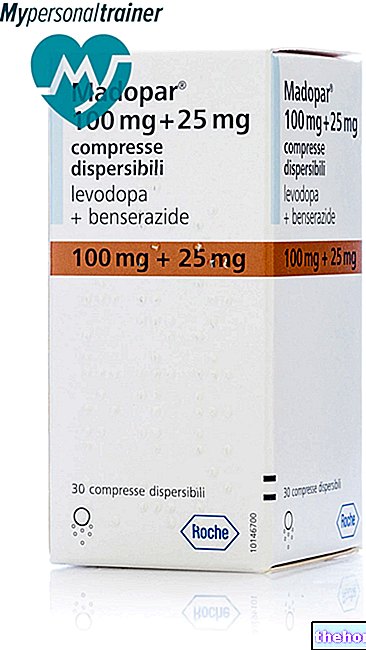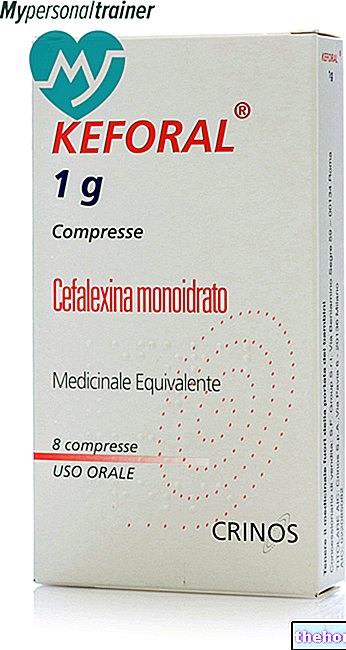Active ingredients: Econazole (econazole nitrate), Triamcinolone (triamcinolone acetonide)
PEVISONE 1% + 0.1% Skin Emulsion
Why is Pevisone used? What is it for?
PHARMACOTHERAPEUTIC CATEGORY
Imidazole and triazole derivatives, Associations
THERAPEUTIC INDICATIONS
Mycosis of the skin characterized by the presence of a severe inflammatory component or by allergic manifestations (redness, blisters, scabs, itching and peeling).
Contraindications When Pevisone should not be used
Hypersensitivity to the active substance or to any of the excipients.
Like all topical corticosteroid products, PEVISONE should not be used in people with specific skin conditions such as tuberculosis, chicken pox, herpes simplex or other viral skin infections. It should not be applied to skin sites where a vaccination has just been given. It is also contraindicated in subjects allergic to econazole nitrate and / or corticosteroids.
Precautions for use What you need to know before taking Pevisone
For external use only. PEVISONE is not indicated for ophthalmic or oral use. In the event of a sensitization or irritation reaction, discontinue use of the product. Corticosteroids applied to the skin may be absorbed in sufficient quantities to produce systemic effects, including adrenal suppression. Systemic absorption can be increased by various factors such as "application over a large area of the skin surface, application on damaged skin, application with occlusive skin dressing and prolonged therapy.
Pediatric patients may demonstrate greater susceptibility to corticosteroid and Cushing's syndrome-induced hypothalamic-pituitary-adrenal (HPA) axis suppression than adult patients due to a high body surface area / body mass ratio. Caution should be exercised when PEVISONE is being used. administered to pediatric patients and treatment should be discontinued if signs of HPA axis suppression or Cushing's syndrome occur.
Topical corticosteroids are associated with skin thinning and atrophy, striae, telangiectasias and purpura.
Topical corticosteroids may lead to an increased risk of dermatologic superinfections or opportunistic infections.
Interactions Which drugs or foods can modify the effect of Pevisone
Tell your doctor or pharmacist if you have recently taken any other medicines, even those without a prescription.
There have been reports of interactions with oral anticoagulants, such as warfarin and acenocoumarol. In patients receiving oral anticoagulants, caution should be exercised and their anticoagulant effect monitored more frequently. A dosage adjustment of the oral anticoagulant drug may be necessary during treatment with PEVISONE and after its discontinuation.
Warnings It is important to know that:
Pregnancy and breastfeeding
Ask your doctor or pharmacist for advice before taking any medicine
Due to systemic absorption, PEVISONE should not be used during the first trimester of pregnancy unless directed by your doctor.
PEVISONE can be used during the second and third trimester of pregnancy if the potential benefit to the mother outweighs the possible risks to the fetus.
Drugs of this class should not be used in large quantities, on large areas of the skin surface or for an extended period of time in pregnant patients.
Effects on ability to drive and use machines
You don't notice.
Important information about some of the ingredients
PEVISONE contains butylhydroxyanisole. May cause local skin reactions (e.g. contact dermatitis) or irritation of the eyes and mucous membranes.
PEVISONE contains benzoic acid. Slightly irritating to the skin, eyes and mucous membranes.
Dose, Method and Time of Administration How to use Pevisone: Posology
PEVISONE must be applied morning and evening on the injured skin surface with a light massage.
The duration of treatment with PEVISONE should not exceed eight days; in the opinion of the doctor, the therapy will then be continued until definitive recovery with the antifungal alone.
Overdose What to do if you have taken too much Pevisone
PEVISONE is for skin application only.
In case of contact with eyes, rinse with clean water or saline and seek medical attention if symptoms persist. In case of accidental ingestion / intake of PEVISONE, notify your doctor immediately or contact the nearest hospital.
If you have any questions about the use of PEVISONE, ask your doctor or pharmacist.
Side Effects What are the side effects of Pevisone
Like all medicines, PEVISONE can cause side effects, although not everybody gets them.
The most commonly reported adverse reactions are: skin burning sensation, skin irritation and erythema. Other reactions reported following clinical trials and post-marketing experience are: contact dermatitis, skin atrophy, pruritus, skin peeling, skin striae, telangiectasia, pain and swelling at the application site.
Locally, on the treated skin, dryness, local inflammation, acne eruptions, light spots or hair growth can sometimes occur.
However, the appearance of undesirable effects may be favored when large skin areas are treated with high doses and for prolonged periods of time, or if the treated areas are kept covered with a bandage.
If these local symptoms are significant, it is advisable to suspend the treatment and consult the doctor.
The use, especially if prolonged, of products for topical use can give rise to sensitization phenomena that manifest themselves with redness and intense itching. If this happens, it is necessary to suspend the treatment and contact a doctor.
Reporting of side effects
If you get any side effects, talk to your doctor or pharmacist. This includes any possible side effects not listed in this leaflet. You can also report side effects directly via the national reporting site at https://www.aifa.gov.it/content/segnalazioni-reazioni-avverse. By reporting side effects you can help provide more information on safety of this medicine.
Expiry and Retention
Expiry: see the expiry date indicated on the package.
The expiry date refers to the product in intact packaging, correctly stored.
Warning: do not use the medicine after the expiry date indicated on the package.
Medicines should not be disposed of via wastewater or household waste. Ask your pharmacist how to dispose of medicines you no longer use. This will help protect the environment.
KEEP THIS MEDICINAL PRODUCT OUT OF THE SIGHT AND REACH OF CHILDREN.
Composition and pharmaceutical form
COMPOSITION
100 g of dermatological milk contain: econazole nitrate 1 g; triamcinolone acetonide g 0.10. Excipients: polyethylene glycol palmito stearate, polyoxyethylene oleic glyceride, liquid paraffin, butylhydroxyanisole, benzoic acid, purified water.
PHARMACEUTICAL FORM
Skin emulsion: bottle of 30 ml
Source Package Leaflet: AIFA (Italian Medicines Agency). Content published in January 2016. The information present may not be up-to-date.
To have access to the most up-to-date version, it is advisable to access the AIFA (Italian Medicines Agency) website. Disclaimer and useful information.
01.0 NAME OF THE MEDICINAL PRODUCT
PEVISONE 1% + 0.1% SKIN EMULSION
02.0 QUALITATIVE AND QUANTITATIVE COMPOSITION
100 g of skin emulsion contain: econazole nitrate 1 g; triamcinolone acetonide 0.10 g.
Excipients with known effects: butylhydroxyanisole, benzoic acid.
For the full list of excipients, see section 6.1.
03.0 PHARMACEUTICAL FORM
Skin emulsion for skin use.
04.0 CLINICAL INFORMATION
04.1 Therapeutic indications
Pevisone is indicated in the therapy of mycoses caused by dermatophytes, yeasts and molds, characterized by the presence of a severe inflammatory component or by allergic manifestations such as mycotic eczema, Hebra's eczema marginato, Herpes circinate, intertrigo, trichophytic folliculitis, mycosis of the beard, dermatitis, etc. .
04.2 Posology and method of administration
Dosage
Pevisone should be applied morning and evening to the injured skin surface with a light massage.
The duration of the treatment should not exceed eight days; as needed, the therapy will then be continued until definitive recovery with the antifungal alone.
Pediatric population
No data are available.
04.3 Contraindications
Hypersensitivity to the active substances, to corticosteroids or to any of the excipients listed in section 6.1.
Like all products containing corticosteroids for local use, Pevisone is contraindicated in specific skin conditions such as tuberculosis, chicken pox, herpes simplex or other viral infections of the skin, or sites where a vaccination has just been given.
04.4 Special warnings and appropriate precautions for use
For external use only. Pevisone is not intended for ophthalmic or oral use.
In case of sensitization or irritation reaction, discontinue use of the drug.
Corticosteroids applied to the skin can be absorbed in sufficient quantities to produce systemic effects, including adrenal suppression. Systemic absorption can be increased by various factors such as application over a large area of skin surface, application to damaged skin, application with occlusive skin dressing and prolonged therapy.
Topical corticosteroids are associated with skin thinning and atrophy, striae, telangiectasias and purpura.
Pediatric patients may demonstrate greater susceptibility to corticosteroid-induced hypothalamic-pituitary-adrenal (HPA) axis suppression and onset of Cushing's syndrome than adult patients due to a high body surface area to body mass ratio.
Caution should be exercised when Pevisone is administered to pediatric patients and treatment should be discontinued if signs of HPA axis suppression or Cushing's syndrome occur.
Local corticosteroids are associated with skin thinning and atrophy, striae, telangiectasias and purpura.
Local corticosteroids may lead to an increased risk of dermatologic superinfections or opportunistic infections.
Pediatric population
No data are available.
Important information about some of the ingredients:
Pevisone contains butylated hydroxyanisole. May cause local skin reactions (e.g. contact dermatitis) or irritation of the eyes and mucous membranes.
Pevisone contains benzoic acid. Slightly irritating to the skin, eyes and mucous membranes.
04.5 Interactions with other medicinal products and other forms of interaction
Econazole is a known inhibitor of CYP3A4 and CYP2C9 cytochromes. Despite limited systemic availability after cutaneous application, clinically relevant interactions with other medicinal products may occur, and some have been reported in patients receiving oral anticoagulants, such as warfarin and acenocoumarol. In patients on oral anticoagulant therapy, caution should be exercised and the INR should be monitored more frequently. Dose adjustment of the oral anticoagulant drug may be necessary during treatment with Pevisone and after its discontinuation.
04.6 Pregnancy and lactation
Pregnancy
There are no adequate and controlled studies, nor epidemiological data, on the undesirable effects deriving from the use of Pevisone in pregnancy.
Pevisone should only be used in the first trimester of pregnancy if the doctor considers it necessary for the patient's health.
Pevisone can be used during the second and third trimester of pregnancy if the potential benefit to the mother outweighs the possible risks to the fetus.
Drugs of this class should not be used in large quantities, on large areas of the skin surface, or for an extended period of time in pregnant patients.
Animal studies have shown reproductive toxicity (fetotoxicity with econazole and teratogenicity with triamcinolone) (see section 5.3). However, the risk in humans is unknown.
Econazole nitrate
Animal studies have shown reproductive toxicity (see section 5.3). In men, after topical application on intact skin, the systemic absorption of econazole is poor (
Triamcinolone acetonide
Animal studies have shown reproductive toxicity (see section 5.3).The few data available in the literature indicate that up to 5% of topically applied triamcinolone applied to the skin is systemically absorbed in humans.
Feeding time
There are no adequate and controlled studies on the local administration of Pevisone during lactation. It is not known whether local administration of Pevisone can result in sufficient systemic absorption to produce detectable quantities in breast milk. Caution should be exercised when Pevisone is administered to women who breastfeed.
Econazole nitrate
After oral administration of econazole nitrate to lactating rats, econazole and / or metabolites are excreted in milk and were found in nursing pups. It is not known whether local administration of econazole nitrate could result in sufficient systemic absorption to produce detectable quantities in breast milk.
Triamcinolone acetonide
There are no animal studies to detect triamcinolone during lactation. It is not known whether local administration of triamcinolone can result in sufficient systemic absorption to produce detectable amounts in breast milk.
Fertility
Econazole nitrate
Results from animal reproduction studies showed no effects on fertility (see section 5.3).
Triamcinolone acetonide
No data are available.
04.7 Effects on ability to drive and use machines
None known.
04.8 Undesirable effects
Clinical trial data
The safety of Pevisone [econazole nitrate (1%) and triamcinolone acetonide (0.1%)] was evaluated in 182 adults who participated in 4 clinical studies. Based on the safety data collected from these clinical studies, the most commonly reported adverse drug reactions (ADRs) (incidence ≥ 1%) were (with incidence%): skin burning sensation (1.6 %), skin irritation (1.6%).
The safety of Pevisone was also evaluated in 101 children (aged 3 months to 10 years) who participated in a clinical study. The most commonly reported adverse event (incidence ≥ 1%) was (with incidence%): erythema (1.0%).
In general, the safety profile of Pevisone is similar for adults and children.
The table below shows the ADRs of Pevisone, deriving from both clinical studies (Adults and Children) and from post-marketing experience, including the adverse reactions already mentioned above.
Frequencies are reported according to the following convention: very common (≥1 / 10); common (≥1 / 100,
Table 1: Adverse Drug Reactions
Locally, on the treated skin, dryness, folliculitis, acne eruptions, hypertrichosis and hypopigmentation can sometimes occur.
However, the appearance of undesirable effects may be favored when large skin areas are treated with high doses and for prolonged periods of time, or if the treated areas are kept covered with a bandage.
Reporting of suspected adverse reactions
Reporting of suspected adverse reactions occurring after authorization of the medicinal product is important as it allows continuous monitoring of the benefit / risk balance of the medicinal product. Healthcare professionals are asked to report any suspected adverse reactions via the national reporting system. "address https://www.aifa.gov.it/content/segnalazioni-reazioni-avverse.
04.9 Overdose
Pevisone is for skin application only. Corticosteroids applied to the skin, including triamcinolone, can be absorbed in sufficient quantities to produce systemic effects. In case of accidental ingestion, nausea, vomiting and diarrhea may occur and be treated with symptomatic therapy. If Pevisone is accidentally applied to the eyes, wash with water or saline and seek medical attention if symptoms persist.
05.0 PHARMACOLOGICAL PROPERTIES
05.1 Pharmacodynamic properties
Pharmacotherapeutic group: imidazole and triazole derivatives, combinations.
ATC code: D01AC20.
Pevisone carries out its action thanks to the combined effects of econazole (antifungal) and corticosteroid (anti-inflammatory). The first, penetrated into the mycotic cell, alters its membranous systems with the appearance and accumulation of decomposition products and consequent blocking of the metabolism of the " RNA, proteins and lipids. The cortisone inhibits the development of all the typical phenomena of inflammation, such as local hyperthermia, redness and edema.
The two components are present in Pevisone in such relationships as not to hinder the mechanism of action of each other.
The clinical researches carried out have demonstrated the usefulness of the use of the combination with respect to the use of the antifungal alone in cases where this is indicated.
05.2 "Pharmacokinetic properties
Econazole nitrate
Absorption
Systemic absorption of econazole is extremely low after local application to the skin. Mean plasma / serum concentrations of econazole and / or its metabolites were observed 1-2 days after administration and were stratum corneum exceed the minimal inhibitory concentration for dermatophytes and inhibitory concentrations are reached in the middle of the dermis.
Distribution
Econazole and / or its metabolites in the systemic circulation are highly (> 98%) bound to serum proteins.
Biotransformation
Econazole which reaches the systemic circulation is extensively metabolised by oxidation of the imidazole ring followed by O-dealkylation and glucuronation.
Elimination
Econazole and its metabolites are eliminated via the kidneys and faeces.
Triamcinolone acetonide
Absorption
The extent of percutaneous absorption of topical corticosteroids is determined by many factors including vehicle, skin barrier integrity, and use of occlusive dressings. Topical corticosteroids can be absorbed from intact skin. Inflammation and / or other pathological processes of the skin increase percutaneous absorption. Occlusive dressings significantly increase percutaneous absorption of topical corticosteroids.
Distribution
Topical corticosteroids, once absorbed through the skin, have similar pharmacokinetics to systemically administered corticosteroids.
Biotransformation
Corticosteroids are primarily metabolised in the liver.
Elimination
Corticosteroids are then excreted via the kidney. Some topical corticosteroids and their metabolites are also excreted in the bile.
05.3 Preclinical safety data
Econazole nitrate
Effects were observed in preclinical studies at exposures considered sufficiently in excess of the maximum human exposure.
Acute toxicity studies show a large margin of safety. In high dose (50 mg / kg / day) repeat dose toxicity studies the liver was identified as a target organ with minimal toxicity and complete recovery.
No significant topical toxicity, phototoxicity, local skin irritation, vaginal irritation or sensitization were noted. Mild eye irritation was noted.
Carcinogenesis / Mutagenesis
Carcinogenicity studies have not been conducted due to the short period of administration proposed in a route that could lead to the development of tumor formations.
In various tests there was no or limited presence of genotoxic effects (structural chromosomal deviations).
Reproductive toxicity
The results of animal studies have shown reproductive toxicity.
Fertility
The results of reproduction studies with econazole showed no effect on fertility.
Pregnancy
Low neonatal survival and fetal toxicity were associated only with maternal toxicity. In animal studies, econazole nitrate showed no teratogenic but embryotoxic and foetotoxic effects in rodents at the maternal subcutaneous dose of 20 mg / kg / day and at the maternal oral dose of 10 mg / kg / day. The significance of these data in man it is not known.
Triamcinolone acetonide
As is common with other corticosteroids, lethality increases with duration of exposure in animal models, with the leading cause of death related to septicemia presumably due to suppression of the animal's immune response mechanism.
Carcinogenesis / Mutagenesis
Long-term animal studies have not been performed to evaluate the carcinogenic potential of topical corticosteroids. In a 104-week study in male rats, triamcinolone acetonide caused an increased incidence of hepatocellular adenoma and adenoma / carcinoma combined at a toxic dose of ≥5 mcg / kg. These results were considered to represent a class e effect. probably with involvement of glucocorticoid receptors No other data on carginogenesis are available.
Triamcinolone acetonide was positive in the micronucleus test (mutagenesis test).
Reproductive toxicity
Triamcinolone (within and beyond the therapeutic range) has been associated with cleft palate in progeny when administered to mice, rats, rabbits and hamsters in pregnancy and pulmonary hypoplasia in rats. In non-human primates, administration of triamcinolone (at system doses central nervous system, neural tube defects, craniofacial and skeletal abnormalities and growth retardation.
Fertility
No data are available.
Pregnancy
No data are available.
06.0 PHARMACEUTICAL INFORMATION
06.1 Excipients
Polyethylene glycol palmito stearate, polyoxyethylene oleic glyceride, liquid paraffin, butylhydroxyanisole, benzoic acid, purified water.
06.2 Incompatibility
None known.
06.3 Period of validity
The product is valid for 2 years.
The data refer to the product in intact and correctly stored packaging.
06.4 Special precautions for storage
Store at a temperature not exceeding 25 ° C.
06.5 Nature of the immediate packaging and contents of the package
High density polyethylene bottle containing 30 ml of skin emulsion.
06.6 Instructions for use and handling
No special instructions for disposal.
07.0 MARKETING AUTHORIZATION HOLDER
Janssen-Cilag SpA
Via M. Buonarroti, 23
20093 COLOGNO MONZESE (Milan)
08.0 MARKETING AUTHORIZATION NUMBER
AIC n. 025036029
09.0 DATE OF FIRST AUTHORIZATION OR RENEWAL OF THE AUTHORIZATION
Date of first authorization: June 2000
Date of most recent renewal: June 2010
10.0 DATE OF REVISION OF THE TEXT
AIFA Determination of 14 October 2015




























